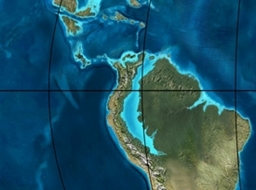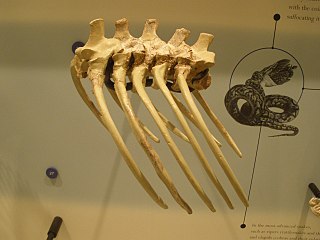 W
WAstrapotheria is an extinct order of South American and Antarctic hoofed mammals that existed from the Late Paleocene to the Middle Miocene, 59 to 11.8 million years ago. Astrapotheres were large and rhinoceros-like animals and have been called one of the most bizarre orders of mammals with an enigmatic evolutionary history.
 W
WThe Bogotá Formation (Spanish: Formación Bogotá, E1-2b, Tpb, Pgb) is a geological formation of the Eastern Hills and Bogotá savanna on the Altiplano Cundiboyacense, Eastern Ranges of the Colombian Andes. The predominantly shale and siltstone formation, with sandstone beds intercalated, dates to the Paleogene period; Upper Paleocene to Lower Eocene epochs, with an age range of 61.66 to 52.5 Ma, spanning the Paleocene–Eocene Thermal Maximum. The thickness of the Bogotá Formation ranges from 169 metres (554 ft) near Tunja to 1,415 metres (4,642 ft) near Bogotá. Fossils of the ungulate Etayoa bacatensis have been found in the Bogotá Formation, as well as numerous reptiles, unnamed as of 2017.
 W
WCarodnia is an extinct genus of South American ungulate known from the Early Eocene of Brazil, Argentina, and Peru. Carodnia is placed in the order Xenungulata together with Etayoa and Notoetayoa.
 W
WThe Huitrera Formation is a geological formation in the Neuquén Basin in northern Patagonian Argentina whose strata date back to the Early Eocene of the Paleogene, or Casamayoran in the South American land mammal age classification.
 W
WMadtsoia is an extinct genus of madtsoiid snakes. It is known from the Eocene of Argentina, the Paleocene of Brazil, the Late Cretaceous (Campanian) of Spain, the Late Cretaceous of India, and the Late Cretaceous (Maastrichtian) of Madagascar and the Coniacian of Niger. Recovered vertebrae of M. pisdurensis are 1.83 centimetres (0.72 in) long and 4.35 centimetres (1.71 in) tall) and pertain to a snake that was approximately 5 metres (16 ft) long.
 W
WNiolamia is an extinct genus of South American meiolaniid turtle. Arthur Smith Woodward classified it as being in the genus Meiolania, but this was not accepted by later authors. The genus is known from the Sarmiento Formation in Argentina. Crossochelys was found to be a synoym in a review of South American Turtles.
 W
WNotostylops is a genus of extinct South American ungulate from Eocene Argentina. Fossils of the genus have been found in the Sarmiento, Casamayor, Andesitas Huancache and Koluel Kaike Formations.
 W
WThe Regadera Formation (Spanish: Formación Regadera, E2r, Tpr) is a geological formation of the Bogotá savanna, Altiplano Cundiboyacense, Eastern Ranges of the Colombian Andes. The predominantly sandstone and conglomeratic formation, with pink shale beds intercalated, dates to the Paleogene period; Middle to Late Eocene epoch, and has a maximum thickness of 765 metres (2,510 ft).
 W
WSebecus is an extinct genus of sebecid crocodylomorph from Eocene of South America. Fossils have been found in among others Patagonia. Like other sebecosuchians, it was entirely terrestrial and carnivorous. The genus is currently represented by a single species, the type S. icaeorhinus. Several other species have been referred to Sebecus, but were later reclassified as their own genera.
 W
WSudamerica, literally "South America" in Spanish, is a genus of mammal from the extinct suborder Gondwanatheria that lived in Patagonia, Argentina and Antarctica from the Middle Paleocene (Peligran), just after the end of the "Age of Dinosaurs", to the Early Eocene (Casamayoran).
 W
WThomashuxleya is an extinct genus of notoungulate mammal, named after famous 19th-century biologist Thomas Huxley.
 W
WTrigonostylops is an extinct genus of South American meridiungulatan ungulate, from the Late Paleocene to Late Eocene of South America and Antarctica. It is the only member of the family Trigonostylopidae.
 W
WXenungulata is an order of extinct and primitive South American hoofed mammals that lived from the Late Paleocene to Early Eocene. Fossils of the order are known from deposits in Brazil, Argentina, Peru, and Colombia. The best known member of this enigmatic order is the genus Carodnia, a tapir-like and -sized animal with a gait similar to living African elephants.